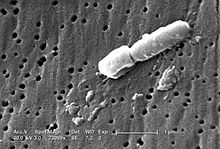
Back كليبسيلا Arabic كليبسيلا ARZ Klebsiel·la Catalan Klebsiella German Klebsiella Spanish Klebsiella Basque کلبسیلا Persian Klebsiella Finnish Klebsiella French Klebsiella Galician
Klebsiella is a genus of Gram-negative, oxidase-negative, rod-shaped bacteria with a prominent polysaccharide-based capsule.[3]
Klebsiella is named after German-Swiss microbiologist Edwin Klebs (1834–1913). Carl Friedlander described Klebsiella bacillus which is why it was termed Friedlander bacillus for many years. The species of Klebsiella are all gram-negative and usually non-motile. They tend to be shorter and thicker when compared to others in the family Enterobacteriaceae.
Klebsiella species are found everywhere in nature. This is thought to be due to distinct sublineages developing specific niche adaptations, with associated biochemical adaptations which make them better suited to a particular environment. They can be found in water, soil, plants, insects and other animals including humans,[4][5] including as part of the human and animal's normal flora in the nose, mouth and intestines.
- ^ Trevisan, V. "Caratteri di alcuni nuovi generi di Batteriaceae [Characteristics of some new genera of Bacteriaceae]." Atti. Accad. Fis.-Med.-Stat. Milano (Ser 4) (1885) 3:92-106.
- ^ "Klebsiella". NCBI taxonomy. Bethesda, MD: National Center for Biotechnology Information. Retrieved 24 April 2019.
- ^ Ryan KJ; Ray CG, eds. (2004). Sherris Medical Microbiology (4th ed.). McGraw Hill. p. 370. ISBN 978-0-8385-8529-0.
- ^ Bagley S (1985). "Habitat association of Klebsiella species". Infect Control. 6 (2): 52–8. doi:10.1017/S0195941700062603. PMID 3882590. S2CID 22799991.
- ^ Cite error: The named reference
Brissewas invoked but never defined (see the help page).
© MMXXIII Rich X Search. We shall prevail. All rights reserved. Rich X Search
